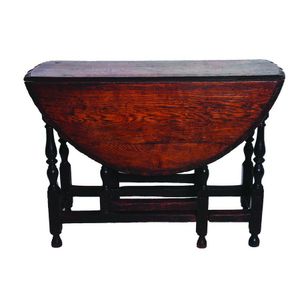Late 19th Century Oak Jacobean Gate Leg Table
You must be a subscriber, and be logged in to view price and dealer details.
Subscribe Now to view actual auction price for this item
When you subscribe, you have the option of setting the currency in which to display prices to $Au, $US, $NZ or Stg.
- Victorian Period - The Victorian period of furniture and decorative arts design covers the reign of Queen Victoria from 1837 to 1901. There was not one dominant style of furniture in the Victorian period. Designers used and modified many historical styles such as Gothic, Tudor, Elizabethan, English Rococo, Neoclassical and others, although use of some styles, such as English Rococo and Gothic tended to dominate the furniture manufacture of the period.
The Victorian period was preceded by the Regency and William IV periods, and followed by the Edwardian period, named for Edward VII (1841 ? 1910) who was King of the United Kingdom and the British Dominions and Emperor of India for the brief period from 1901 until his death in 1910. - Jacobean - Jacobean is the name applied to the style of furniture and decorative arts in vogue from about 1600 to 1630 which includes the reign of James I (1603-1625). The most common timber used is oak, and it is ornamented with turning and elaborate carving. Characteristic of decoration of furniture in this style are bun feet, mortice and tenon joints (replacing dowell joints) and 'X' frame chairs.
The style was revived in the 19th furniture (Jacobean Revival or "Jacobean style") as represented by most of the furniture coming onto the market in Australia, that is described as "Jacobean". - Oak - Native to Europe and England, oak has been used for joinery, furniture and building since the beginning of the medieval civilisation. It is a pale yellow in colour when freshly cut and darkens with age to a mid brown colour.
Oak as a furniture timber was superceded by walnut in the 17th century, and in the 18th century by mahogany,
Semi-fossilised bog oak is black in colour, and is found in peat bogs where the trees have fallen and been preserved from decay by the bog. It is used for jewellery and small carved trinkets.
Pollard oak is taken from an oak that has been regularly pollarded, that is the upper branches have been removed at the top of the trunk, result that new branches would appear, and over time the top would become ball-like. . When harvested and sawn, the timber displays a continuous surface of knotty circles. The timber was scarce and expensive and was used in more expensive pieces of furniture in the Regency and Victorian periods.
This item has been included into following indexes:
Visually similar items

An antique country style fruitwood drop side table, 19th century, in mellow light honey tones, the circular drop side table with pull out supports, raised upon knopped and turned slender legs, with peg joins and having a good patina. Height 72 cm. Diameter

A George III red walnut wake table, Irish, 18th century. 72 cm high, 182 cm wide and 52 cm deep closed. Provenance: Private Collection, Melbourne

An 18th century English oak gate leg table, the oval top with carved thumbnail border and rule joints, turned supports, stretcher base and a single drawer at one end. Extended 99 cm x 106 cm x 70 cm

George III oak oval gate leg dining table drawer to one end on squared chamfered tapering legs
